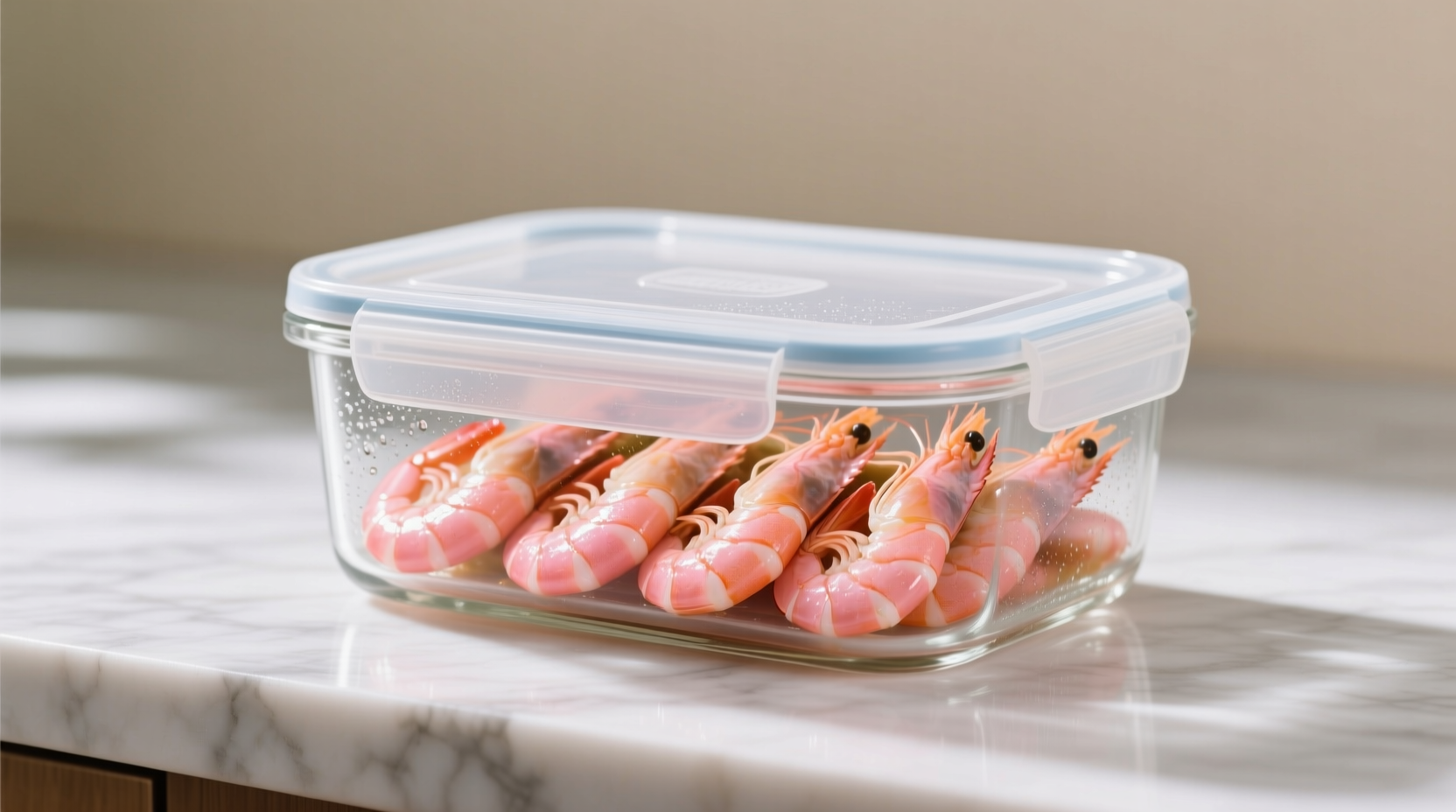Cooked shrimp stays safe to eat for 3-4 days when properly stored in a refrigerator at 40°F (4°C) or below. This timeframe comes directly from the USDA Food Safety and Inspection Service, the leading authority on food safety guidelines in the United States.
Discover exactly how to maximize freshness, recognize spoilage signs, and safely extend shelf life with professional storage techniques that prevent foodborne illness while reducing kitchen waste.
The Critical 3-4 Day Rule: Why Timing Matters
When you bring home cooked shrimp from a restaurant or finish preparing it at home, the clock starts ticking immediately. According to the USDA Food Safety and Inspection Service, cooked seafood maintains peak safety for just 3-4 days under proper refrigeration conditions.
This narrow window exists because bacteria multiply rapidly between 40°F and 140°F—the "danger zone" where pathogens like Vibrio and Listeria thrive. Shrimp's high moisture content and protein composition create an ideal breeding ground for these microorganisms once cooked.
| Storage Method | Maximum Safe Duration | Temperature Requirement |
|---|---|---|
| Refrigerator (properly stored) | 3-4 days | 40°F (4°C) or below |
| Refrigerator (improper storage) | 1-2 days | Above 40°F |
| Freezer (airtight container) | 3-6 months | 0°F (-18°C) |
Maximizing Freshness: Professional Storage Techniques
How you store cooked shrimp dramatically impacts its actual shelf life. Follow these evidence-based methods to ensure you get the full 3-4 days of freshness:
Immediate Cooling Process
Never place hot shrimp directly in your refrigerator. The FoodSafety.gov recommends cooling cooked seafood within two hours of preparation (one hour if room temperature exceeds 90°F). Use these steps:
- Spread shrimp in a single layer on a clean baking sheet
- Place in refrigerator for 20-30 minutes until completely cooled
- Transfer to airtight container before long-term storage
Container Selection Matters
Glass containers with tight-sealing lids outperform plastic storage containers by maintaining more consistent temperature and preventing odor transfer. If using plastic, choose food-grade containers specifically designed for freezer/refrigerator use.

Recognizing Spoilage: Your Safety Checklist
Don't rely solely on the calendar—always perform these sensory checks before consuming refrigerated cooked shrimp:
Visual Indicators
- Color change: Pink or red shrimp turns dull or grayish
- Texture: Slimy film develops on surface (not to be confused with cooking sauce)
- Discoloration: Dark spots appear on flesh
Olfactory Warning Signs
Fresh cooked shrimp has a mild ocean scent. Discard immediately if you detect:
- Strong ammonia-like odor
- Sour or acidic smell
- Any unpleasant "off" odor
Safety First: Understanding the Risks
Consuming spoiled shrimp carries serious health consequences. The Centers for Disease Control and Prevention reports that seafood causes approximately 128,000 foodborne illness cases annually in the United States.
High-risk groups including pregnant women, young children, older adults, and immunocompromised individuals face potentially severe complications from foodborne pathogens commonly found in spoiled seafood.
Extending Shelf Life: Freezing Cooked Shrimp
When you can't consume shrimp within 3-4 days, freezing preserves quality and safety:
Proper Freezing Technique
- Cool shrimp completely using the two-stage method described earlier
- Place in freezer-safe container with 1/2 inch headspace for expansion
- Remove as much air as possible from packaging
- Label with contents and freezing date
- Store at 0°F (-18°C) or below
For best quality, consume frozen cooked shrimp within 3 months. While technically safe indefinitely when frozen, texture and flavor degrade over time.
Reheating Safety Protocol
When preparing refrigerated cooked shrimp, proper reheating eliminates potential pathogens:
- Heat to internal temperature of 145°F (63°C)
- Use food thermometer to verify temperature
- Reheat only once—never repeatedly warm and re-refrigerate
Practical Storage Timeline
Understanding the progression of spoilage helps identify when shrimp becomes unsafe:
| Time After Cooking | Condition | Recommended Action |
|---|---|---|
| 0-2 hours | Safe at room temperature | Cool for refrigeration |
| Day 1-2 | Peak freshness | Enjoy as is or incorporate into recipes |
| Day 3 | Beginning quality decline | Use in cooked dishes (pasta, stir-fry) |
| Day 4 | Potential safety risk | Discard if any doubt about freshness |
| Day 5+ | High risk of foodborne illness | Immediately discard |
Special Considerations for Different Shrimp Preparations
Certain cooking methods and ingredients affect shelf life:
- Shrimp in sauce: 2-3 days maximum (sauces with dairy reduce shelf life)
- Grilled shrimp: 3-4 days (dry cooking method preserves slightly longer)
- Breaded shrimp: 2-3 days (breading absorbs moisture faster)
- Shrimp salad: 2 days maximum (mayonnaise-based dressings spoil quickly)
Reducing Food Waste Without Compromising Safety
Many home cooks unnecessarily discard safe shrimp while others risk illness by keeping it too long. Follow these practical guidelines:
- Store shrimp in the coldest part of your refrigerator (usually the back, bottom shelf)
- Keep dairy products separate to prevent cross-contamination
- Use glass containers which maintain more consistent temperature
- Label containers with preparation date using masking tape
- When in doubt, throw it out—never taste questionable seafood











 浙公网安备
33010002000092号
浙公网安备
33010002000092号 浙B2-20120091-4
浙B2-20120091-4